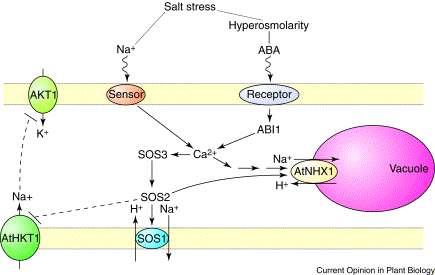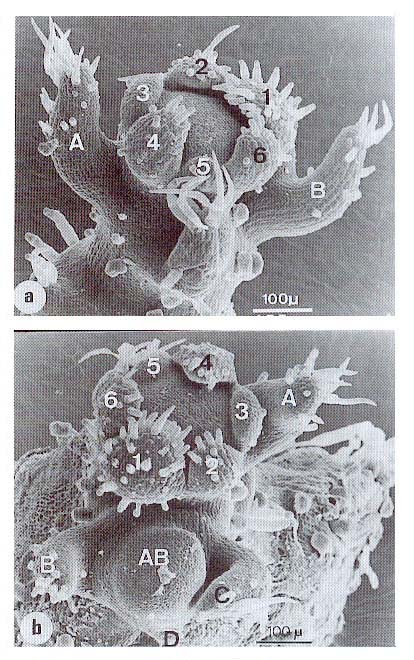The Unit of Plant Biology - Louvain-la-Neuve
Research Focus
The research interests of the Unit of Plant Biology are focused on two main topics: i) investigating a key developmental change in plant life cycle, namely flowering (J.-M. Kinet), ii) understanding the physiological, genetic and biochemical basis of sensing and responding to environmental cues such as drought, cold, mineral toxicity and other abiotic signals by which plants interact with their surroundings (H. Batoko and S. Lutts). A comprehensive set of approaches are currently used including whole plant physiology (S. Lutts and J.M. Kinet), biochemistry (S. Lutts), histology (J.-M. Kinet), cell and molecular biology (H. Batoko). A variety of plant species are investigated (Arabidopsis thaliana, rice, xero-halophyte species belonging to the genus Atriplex, Fagopyrum esculentum, etc.), the choices being driven mostly by conceptual or specific hypotheses-based suitability.
Tomato is among the main model-plants used in the laboratory. The main objectives of the ongoing researchs are:
to study the salt tolerance mechanisms in Lycopersicon esculentum and its wild relatives (namely L. chesmanii and L. pennellii) in relation to the role of the SOS pathway in ion homeostasis (Fig. 1)

Figure 1. Zhu, J.-K., 2003
Curr.Op. Plant. Biol., 6, 441-445to characterize the impact of Cd in relation to oxidative stress and phytochelatine synthesis.
to characterize genes involved in flowering. Up to now, the main focus was on uf mutant which initiates single flowers instead of multi- flowered inflorescences (Fig. 2). Ongoing work has already established that UNIFLORA is a pivotal gene that regulates floral transition and the identity of the inflorescential meristem in tomato. Other mutations that are concomitantly investigated include compound inflorescence, jointless, blind, single flower truss and self pruning.


Figure 2. The reproductive structure of the uf tomato mutant. Left: solitary, normal and fertile flowers are consistently produced instead of inflorescences. Right: SEM views of a same uf-induced floral structure showing that the single-flower phenotype results from the inability of the plant to produce an inflorescence and not from post-initiation abortion processes affecting young flower buds. The isolated flower is seen with its 6 sepals (1 to 6) and was initiated after the formation of the 12th leaf (A). An axillary bud (AB) bearing three leaves (B,C, D) has been initiated at the basis of the flower (Dielen, et al., 1998. Plant Growth Regul., 25, 149-157).
Some Publications
Bajji, M., Kinet, J.M. and Lutts, S. 1998. Salt stress effects on roots and leaves of Atriplex halimus L. and their corresponding callus cultures. Plant Sci., 137, 131-142.
Lutts, S., Majerus, V. and Kinet, J.M. 1999. NaCl effects on proline metabolism in rice (Oryza sativa ) seedlings. Physiol. Plant., 105, 450- 458.
Batoko, H., Zheng, H.-Q., Hawes, C. and Moore, I. 2000. A Rab1 GTPase is required for transport between the endoplasmic reticulum and Golgi apparatus and for normal Golgi movement in plants. Plant Cell, 12, 2201-2217
Dielen, V., Lecouvet, V., Dupont, S. and Kinet, J.M. 2001. In vitro control of floral transition in tomato (Lycopersicon esculentum Mill.), the model for autonomously flowering plants, using the late flowering uniflora mutant. J. Exp. Bot., 52, 715-723.
Geelen, D., Leyman, B., Batoko, H., Di Sansebastiano, G.-P., Moore, I. and Blatt, M.R. 2002. The abscissic acid-related SNARE homolog NtSyr1 contributes to secretion and growth: evidence from competition with its cytosolic domain Plant Cell, 14, 387-406.
Martinez, J.P., Ledent, J.F., Bajji, M., Kinet, J.M. and Lutts, S. 2003. Effect of water stress on growth, Na+ and K+ accumulation and water use efficiency in relation to osmotic adjustment in two populations of Atriplex halimus L. Plant Growth Regul., 41, 63-73.
Dielen, V., Quinet, M., Chao, J., Batoko, H., Havelange, A. and Kinet, J.M. 2004. UNIFLORA, a pivotal gene that regulates floral transition and meristem identity in tomato (Lycopersicon esculentum Mill.). New Phytol., 161, 393-400.
Quinet, M., Cawoy, V., Lefèvre, I., Van Miegroet, F., Jacquemart, A.L. and Kinet, J.M. 2004. Inflorescence structure and control of flowering time and duration by light in buckwheat (Fagopyrum esculentum Moench.). J. Exp. Bot., 55, 1509-1517.
Lutts, S., Lefèvre, I., Delpérée, C., Kivits, S., Dechamps, C., Robledo, A. and Correal, E. 2004. Heavy metal accumulation by the halophyte species Atriplex halimus, a promising species for phytoremediation purposes. J. Environm. Qual., 33, in press.
Contact
Jean-Marie Kinet - Stanley Lutts - Henri Batoko
Université catholique de Louvain
Unité de Biologie végétale
Département de Biologie et Institut des Sciences de la Vie
(ISV)
Croix du Sud, 5 (bte 13)
B-1348 Louvain-la-Neuve
Belgium
Fax : +32 10 47 34 35
JMK : Tel : +32 10 47 20 50 - Email : kinet@bota.ucl.ac.be
SL : Tel : +32 10 47 20 37 - Email : lutts@bota.ucl.ac.be
HB : Tel : +32 10 47 92 65 - Email : batoko@bota.ucl.ac.be
For more information, please visit the lab's website at
http://www.bota.ucl.ac.be/Acces.html
(note that an english version of the site will be launched
soon).



